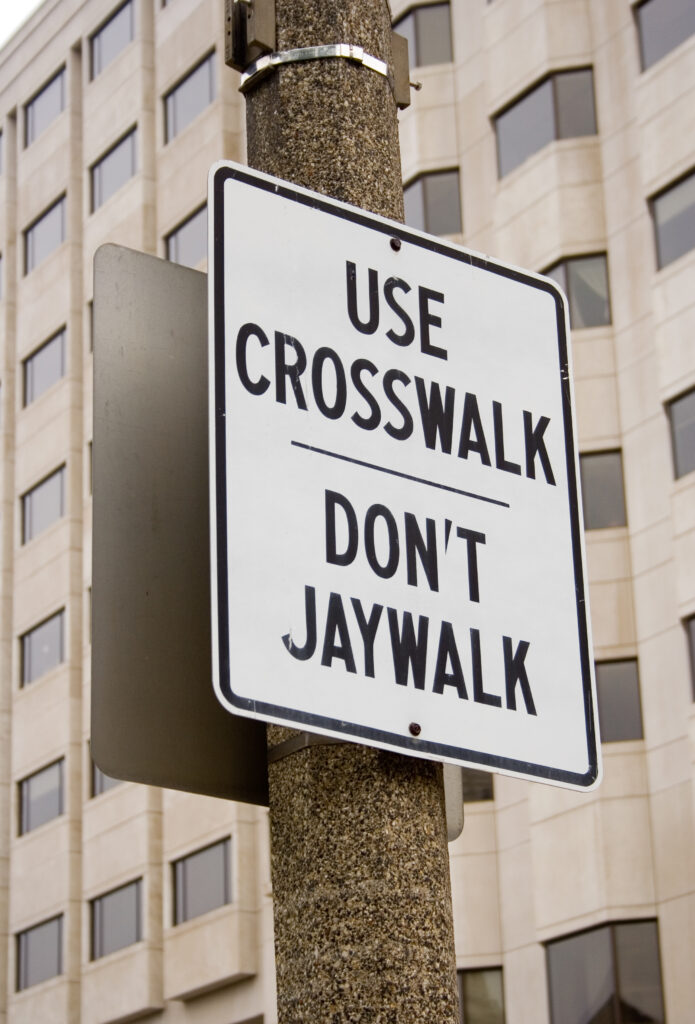
When it comes to jaywalking, the state of California has a notorious reputation. Prior to 2023, it was known as the state with the strictest laws against jaywalking in the nation. You could receive major fines or jail time for simply crossing the street in the wrong location. For many, it was a costly and unfortunate mistake that led to regret.
Since then, California jaywalking laws have changed to become less punitive and more realistic. Have you kept up with the latest changes? When is jaywalking illegal in California, and how do you avoid breaking this law?
We’ve created this guide to answer your questions about Jaywalking in California. We’ve also included the most current updates about the Freedom to Walk Act. Read on to learn everything you need to know about crossing the street in The Golden State.
What Is Jaywalking?
By definition, jaywalking occurs when a pedestrian crosses the street against local traffic regulations. This can be as simple as crossing in the middle of the street rather than using a crosswalk. Although there may not be any cars present, this action can be unsafe. Jaywalking often leads to vehicular accidents, pedestrian injuries or deaths.
Examples of jaywalking include:
- Crossing the street against a red light
- Crossing the street between parked cars
- Crossing the street between cars in motion
- Running across a busy highway
Typically, these laws are in place to protect both pedestrians and drivers. However, in many cases, they may be frustrating. For example, it seems silly to wait at a crosswalk when there are no vehicles present on the road.
What Is the New Law for Jaywalking in California?

The newest jaywalking law in California is the Freedom to Walk Act. This law went into motion on January 1st, 2023. As of that date, jaywalking is legal in California under most circumstances.
This will be the case until January 1st, 2029. At that time, lawmakers will revisit the law and determine if it improved life for California citizens.
What Does This Mean For California Drivers and Pedestrians?
Ultimately, this new law should change very little for California drivers. Looking out for pedestrians is the minimum responsibility when operating a vehicle. Some drivers may have to take more care when driving within the state. Lawmakers hope this will lead to more careful driving and fewer accidents overall.
Likewise, there will be less punitive action taken against pedestrians.
Is Jaywalking Legal in California, or Did California Ban Jaywalking?
The Freedom to Walk Act means pedestrians will not receive a citation, a fine, or jail time for jaywalking. There are still some exceptions to this law. Pedestrians are still responsible for looking out for hazards, such as oncoming vehicles.
You may still receive a citation if you cross in a patently unsafe situation. For example, running across a busy street against traffic is a reckless act. An officer can still legally issue you a citation for putting yourself and others at risk.
The law states that pedestrians and drivers alike have a “Duty of Care” to one another. In other words, they ask that you be kind and cautious while on the road. Do not needlessly put yourself or others at risk.
Jaywalking Incident? Bail Hotline Can Help.
California jaywalking laws are in flux. If you have made a mistake leading to an arrest, we want to help. Our goal is to give people a second chance when they find themselves in jail for a minor offense.
You have a right to bail per the 8th Amendment. Our hope is to make posting bond as stress-free and affordable as possible. We’ll help you determine a reasonable payment plan that helps you get back to your family and your life.
Do you have questions about jaywalking laws or posting bail? Call the experts at Bail Hotline, and we’ll help. We’re ready and waiting to help you or a loved one anywhere in CA.